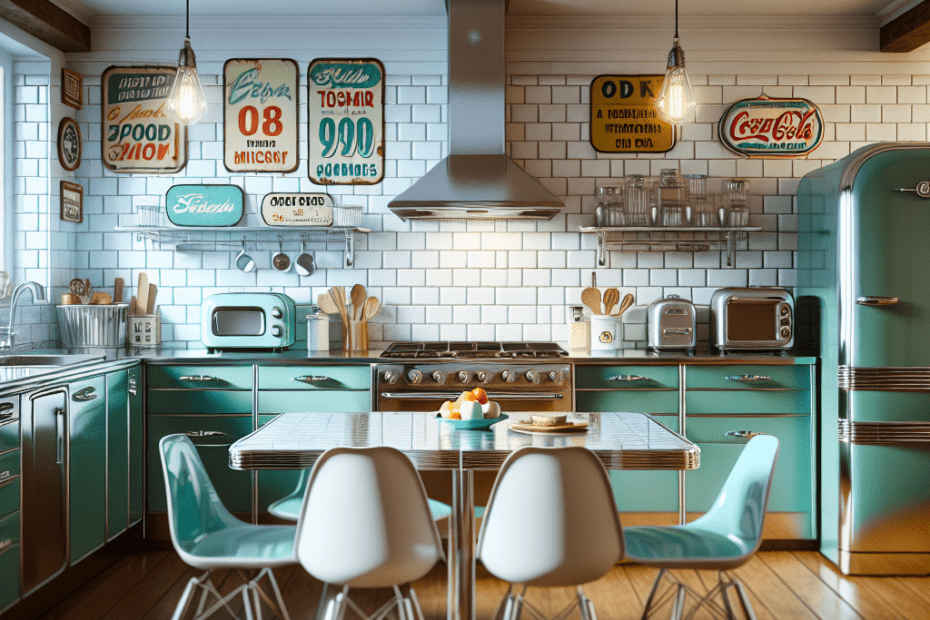Introduction
Many people love the charm of retro kitchens but want the convenience that comes with modern appliances. Mixing retro style with the latest technology can seem challenging, but with the right approach, individuals can create a space that marries the best of both worlds. A retro kitchen with modern appliances offers the perfect blend of nostalgic design and contemporary functionality.
Why Choose a Retro Kitchen Design?
Retro kitchens are experiencing a resurgence in popularity, mainly due to their unique character, vibrant colors, and playful details. According to a 2022 survey by Home Decor Trends, retro-inspired designs have seen a 15% increase in popularity over the past year. People are increasingly drawn to the elements of 50s and 60s design, such as bold patterns, soft pastels, and quirky accessories.
Mixing Retro Elements with Modern Appliances
Combining retro elements with modern appliances requires thoughtful integration. Here are some tips to consider:
- Steel and Chrome Finishes: Many modern appliances come with sleek steel or chrome finishes. These materials can complement retro designs that often feature similar metallic accents.
- Bold Color Choices: Retro kitchens often include bright colors like red, teal, and mustard. Modern appliances in these colors or neutral tones like white or silver harmonize effortlessly with retro palettes.
- Matte and Glossy Surfaces: Utilize glossy retro countertops and matte-finishes appliances to create an exciting visual contrast.
- Retro Patterns: Opt for checkerboard flooring or vintage tile designs as a backdrop for contemporary gadgets.
Design Ideas for a Retro Kitchen with Modern Appliances
They can consider incorporating the following ideas to enhance the retro look while enjoying modern conveniences:
1. Statement Lighting
Pendant lighting is a key feature in retro kitchens. Go for oversized fixtures with a touch of gloss or color to add flair. Combine with bright LED bulbs to keep the space well-lit, offering both style and sustainability.
2. Retro-Inspired Furniture
Seek out furniture that mimics mid-century design. Consider using rounded dining sets with vinyl seating and chrome legs. These pieces often pair well with the minimalistic look of today’s major appliance brands.
3. Integrating Modern Technology
Smart technology can be incorporated seamlessly into a retro kitchen. For example, they can choose refrigerators with digital displays but classic looks. Many manufacturers now offer appliances that have the appearance of traditional devices but function like the latest models.
Table: Pros and Cons of Mixing Retro and Modern Elements
| Pros | Cons |
|---|---|
| Unique design blending different eras | May require custom solutions |
| Combines nostalgia with technology | Potential for style clash |
| Potential increase in home value | Higher initial setup costs |
| Flexible design footings | Requires careful planning |
Financial Considerations
The cost of updating a kitchen can vary significantly. Modern appliances typically range based on brand and features. On average, they might expect to spend between $2000 to $5000 on a suite of efficient new appliances. However, they should weigh these costs against the long-term benefits, such as energy savings and enhanced resale value. According to the National Association of Home Builders, kitchen remodels can offer a 62% return on investment.
Key Takeaways
- Retro kitchens are gaining popularity for their color and character.
- Mix retro elements with modern appliances for efficient and attractive spaces.
- Careful planning can prevent style clashes and enhance design aesthetics.
- Investing in a retro-modern kitchen can provide financial benefits over time.
FAQ
1. Can you integrate smart tech in a retro kitchen?
Yes, many smart appliances are designed to blend aesthetically with retro-themed homes, offering both function and style without sacrificing appearance.
2. What colors are best for a retro kitchen?
Vibrant colors such as red, teal, yellow, and pastel shades are ideal, as they capture the essence of the 50s and 60s.
3. Is it expensive to mix retro and modern elements?
The costs can vary, but combining retro aspects with modern conveniences typically entails higher initial design costs which might be offset by efficiency and home value gains.
4. How do you prevent a style clash between retro and modern elements?
Use common materials or color schemes to create coherence between different styles and ensure that features complement rather than overshadow each other.
5. Why are retro kitchens becoming popular?
Retro kitchens offer a sense of nostalgia and uniqueness with their standout aesthetics and bold designs, appealing to those who appreciate both vintage charm and character.
